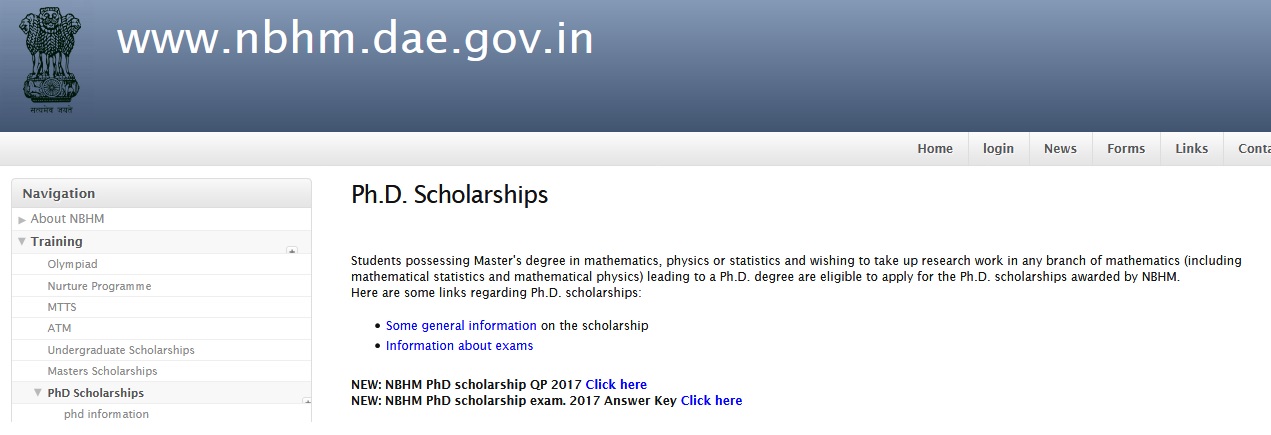NBHM Research Scholarships Screening Test Sample Question Paper 2016 : National Board For Higher Mathematics
Organisation : National Board For Higher Mathematics
Exam : Research Scholarships Screening Test
Document Type : Sample Question Paper
Year : 2016
Website : http://www.nbhm.dae.gov.in/phd.html
Download Sample Question Paper : https://www.pdfquestion.in/uploads/8516nbhmra16.pdf
NBHM Research Scholarships Screening Test
Time Allowed: 150 Minutes
Maximum Marks: 40
Instructions To Candidates :
** Please ensure that this booklet contains 10 numbered (and printed) pages. The back of each printed page is blank and can be used for rough work.
Related : National Board for Higher Mathematics PhD Scholarship Test Sample Question Paper : www.pdfquestion.in/7232.html
** There are sections, containing ten questions each, entitled Algebra, Analysis, Topology, Calculus & Differential Equations and Miscellaneous. Answer as many questions as possible. The assessment of the paper will be based on the best four sections. Each question carries one point and the maximum possible score is forty.
** Answer each question, as directed, in the space provided in the answer booklet, which is being supplied separately. This question paper is meant to be retained by you and so do not answer questions on it.

** In certain questions you are required to pick out the qualifying statements from multiple choices. None of the statements, or one or more than one statement may qualify. Write none if none of the statements qualify, or list the labels of all the qualifying statements amongst (a), (b), and (c)).
** Points will be awarded for questions involving more than one answer only if all the correct answers are given. There will be no partial credit.
** Calculators are not allowed.
Section 1 – Algebra
1.1 With the usual notations, compute aba-1 in S5 and express it as the product of disjoint cycles, where a = (1 2 3)(4 5) and b = (2 3)(1 4)
1.2 Consider the following permutation
1 2 3 4 5 6 7 8 9 10
7 4 10 6 2 9 8 1 5 3
a. Is this an odd or an even permutation?
b. What is its order in S10?
1.3 Which of the following statements are true?
a. Let G be a group of order 99 and let H be a subgroup of order 11. Then H is normal in G.
b. Let H be the subgroup of S3 consisting of the two elements {e,a) where
e is the identity and a = (1 2). Then H is normal in S3.
c. Let G be a finite group and let H be a subgroup of G. Define
Then W is a normal subgroup of G.
1.4 Consider the ring C[0; 1] with the operations of point wise addition and point wise multiplication. Give an example of an ideal in this ring which is not a maximal ideal.
1.5 Compute the (multiplicative) inverse of 4x+3 in the field
1.6 Let A 2 M5(R). If A = (aij), let Aij denote the cofactor of the entry aij ; 1 i; j 5. Let b A denote the matrix whose (ij)-th entry is Aij ; 1 i; j 5.
a. What is the rank of b A when the rank of A is 5?
b. What is the rank of b A when the rank of A is 3?
1.7 Write down the minimal polynomial of A 2 Mn(R), where
1.8 Let V = R5 be equipped with the usual euclidean inner-product. Which of the following statements are true?
a. If W and Z are subspaces of V such that both of them are of dimension 3, then there exists z 2 Z such that z 6= 0 and z ? W.
b. There exists a non-zero linear map T : V ! V such that ker(T)\W 6= f0g for every subspace W of V of dimension 4.
c. Let W be a subspace of V of dimension 3. Let T : V ! W be a linear map which is surjective and let S : W ! V be a linear map which is injective. Then, there exists x 2 V such that x 6= 0 and such that S T(x) = 0.
1.9 Which of the following statements are true?
a. Let A 2 M3(R) be such that A4 = I; A 6= I. Then A2 + I = 0.
b. Let A 2 M2(R) be such that A3 = I; A 6= I. Then A2 + A + I = 0.
c. Let A 2 M3(R) be such that A3 = I; A 6= I. Then A2 + A + I = 0.
1.10 Find an orthogonal matrix P and a diagonal matrix D, both in M2(R), such that PTAP = D, where
Section 2 – Analysis
2.1 Let fang be a sequence of real numbers such that
2.2 Let f : [0;1[! [0;1[ be a continuous function such that
Which of the following statements are true?
a. The sequence ff(n)gn2N is bounded.
b. f(n) ! 0 as n ! 1.
c. The series P1 n=1 f(n) is convergent.
2.5 Write down the Taylor expansion (about the origin) of the function
2.6 Use the preceding exercise to nd the sum of the series:
2.7 Let ffng be a sequence of continuous real valued functions dened on R converging uniformly on R to a function f. Which of the following statements are true?
a. If each of the functions fn is bounded, then f is also bounded.
b. If each of the functions fn is uniformly continuous, then f is also uniformly continuous.
c. If each of the functions fn is integrable, then
2.8 Let f : R ! R be a given function. Consider the following statements:
A: The function f is continuous almost everywhere.
B: There exists a continuous function g : R ! R such that f = g almost everywhere.
Which of the following implications are true?
a. A ) B.
b. B ) A.
c. A , B.
[embeddoc url=”https://www.pdfquestion.in/uploads/8516nbhmra16.pdf”]